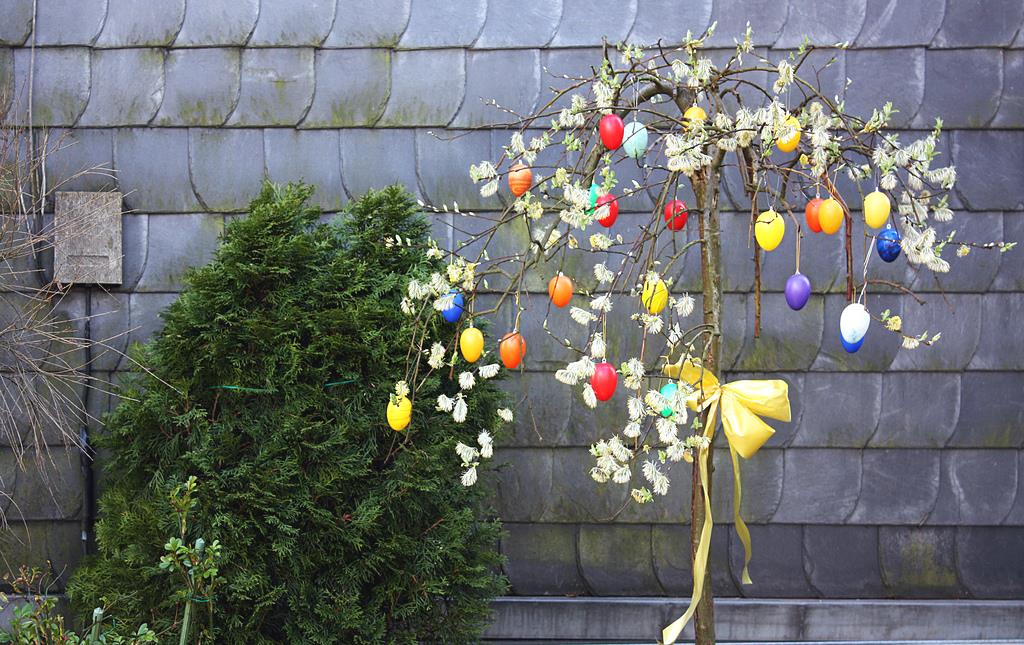
The Origins Of The Easter Tree Tradition
The tradition of decorating trees with hanging eggs and ornaments is believed to have deep historical roots, drawing from both Christian and pre-Christian customs. In pre-Christian Europe, trees held spiritual significance for many pagan cultures. They symbolized life, renewal, and fertility-concepts that closely align with the themes of Easter. The ancient Germans, Celts, and Slavs often associated trees with gods and spirits, decorating them during seasonal festivals to ensure prosperity and good fortune.
With the spread of Christianity, many pagan traditions were adapted to fit Christian narratives. The concept of decorating trees to mark seasonal changes was incorporated into Easter celebrations, with eggs-a universal symbol of new life-becoming the primary decoration. The egg's association with resurrection and rebirth made it an appropriate emblem for Easter festivities.
The Heart of the Easter Tree Tradition is GermanyGermany is widely credited with popularizing the Easter tree as we know it today. The practice of hanging eggs on trees or branches dates back centuries, with documented cases appearing in the 18th and 19th centuries. Families would collect twigs and branches, place them in vases, and adorn them with eggs, flowers, and other decorations. Over time, outdoor trees were also decorated, particularly in gardens and public spaces.
One of the most famous examples of an Easter tree was created by the Kraft family in Saalfeld, Germany. In the mid-20th century, Volker Kraft began decorating a tree in his yard with just a few colored eggs. As the years passed, the number of eggs increased dramatically, reaching over 10,000 ornaments by the early 21st century. The Kraft family's tree became a tourist attraction, inspiring others to adopt the tradition.
Symbolism of the Easter Tree DecorationsEach element of the Easter tree carries significant meaning. The tree itself symbolizes life and growth, reinforcing the themes of renewal and resurrection associated with Easter. The eggs, often painted in bright colors, represent fertility, new beginnings, and Christ's resurrection.
In some cultures, the process of decorating Easter eggs is an elaborate affair. In Eastern Europe, for instance, the art of“pysanky” involves intricate designs drawn on eggs using wax and dye techniques. These beautifully crafted eggs are sometimes used to adorn Easter trees, adding cultural depth to the tradition.
Other decorations may include ribbons, flowers, and even small figurines. Ribbons in pastel shades symbolize joy and celebration, while flowers like daffodils and tulips reinforce the arrival of spring and nature's renewal. Some Easter trees also incorporate small birds or butterflies to symbolize transformation and the beauty of life.
The Easter Tree Beyond GermanyThough its roots lie in Germany, the tradition of the Easter tree has spread to various parts of the world, particularly in European countries such as Sweden, Austria, and Switzerland. In Sweden, a similar tradition exists in the form of“Påskris,” where birch twigs are decorated with feathers, eggs, and ornaments. In Austria and Switzerland, households and churches display beautifully adorned Easter trees as part of their seasonal celebrations.
In recent years, the custom has gained popularity in the United States, the United Kingdom, and other non-European regions. Many families now incorporate Easter trees into their holiday decorations, often as a table centerpiece or as a way to engage children in festive activities. Commercial retailers have also embraced the trend, selling decorative trees and ornaments specifically designed for Easter celebrations.
Modern Interpretations and DIY Easter TreesIn contemporary times, people have embraced creative ways to decorate Easter trees. While traditional egg decorations remain popular, modern Easter trees may feature artificial eggs, LED lights, and even personalized ornaments. Some families prefer to use real branches placed in vases, while others opt for pre-made decorative trees sold in stores.
For those who enjoy DIY projects, making an Easter tree at home can be a fun and meaningful activity. Here are a few simple steps to create your own Easter tree:
Gather branchesChoose small tree branches or twigs, either from your backyard or a craft store. Arrange them in a vase or planter to serve as your tree.
Decorate eggsUse real or artificial eggs, and paint them in vibrant colors or patterns. You can also use stickers, glitter, or fabric for extra embellishment.
Add ribbons and flowersTie pastel-colored ribbons onto the branches and add small artificial flowers to enhance the tree's festive appearance.
Incorporate lightsFor an extra touch of magic, consider wrapping fairy lights around the branches.
Personalize with symbolsAdd small charms, wooden ornaments, or personal mementos that reflect your family's Easter traditions.
Final ThoughtsThe Easter tree tradition is a beautiful and meaningful way to celebrate Easter and the arrival of spring. While its origins are deeply rooted in both pagan and Christian customs, it has evolved into a global phenomenon that continues to bring joy to families and communities. Whether adorned with simple eggs and ribbons or elaborate handcrafted ornaments, the Easter tree serves as a vibrant symbol of life, renewal, and festive cheer. As this tradition continues to spread and adapt, it remains a cherished part of Easter celebrations around the world.

Legal Disclaimer:
MENAFN provides the
information “as is” without warranty of any kind. We do not accept
any responsibility or liability for the accuracy, content, images,
videos, licenses, completeness, legality, or reliability of the information
contained in this article. If you have any complaints or copyright
issues related to this article, kindly contact the provider above.


















Comments
No comment